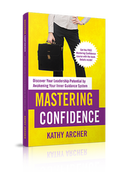|
Staff recognition and appreciation are important. How important?
Well, let's say essential. When staff recognition hits the mark (according to Gallup), employees are 73% less likely to "always" or "very often" feel burned out.
When staff recognition hits the mark (again, according to Gallup), employees are 56% less likely to be looking or watching for job opportunities.
For employee recognition to be effective, it has to land. In the stats above, Gallup said: When it hits the mark... Sometimes, what we think of as good recognition, isn't landing in the way we intend it to. Let me ask you...
I'm guessing you said yes to at least one of those, so you know what it feels like when recognition doesn't land. It doesn't feel so great. So, how do you make your employee recognition stick? Let's look at 5 considerations that will help! 5 things that can make employee recognition land and feel good to the employee: Timeliness: Recognize the employee after their achievement or contribution as soon as possible so they feel their efforts are valued and appreciated. Hey Sarah, thanks for staying late and helping clean up. It's been a long day for all of us, and I appreciate the extra help! Specificity: Be clear about the specific behaviour, action, or contribution you recognize the employee for, so they understand what they did well and can continue to do so in the future. The way you handled that guardian was impressive, Lindsey. They were argumentative, and I noticed you kept your body posture open. You remained curious and asked lots of questions when it would have been easy to get defensive. As a result, I watched the situation settle down. It was impressive to see you apply the skills you learned in your conflict resolution course. Sincerity: Be genuine in your recognition and communicate your appreciation in a way that feels authentic and heartfelt. There is no example here, but genuineness isn't what you say. It's how you say it. It's a feeling, and you have to feel it before they will feel it! Personalization: Tailor the recognition of the individual's preferences and needs to feel personalized and relevant to them. I so appreciate everyone's contribution to the move of offices. It was a lot of work. So I wanted to give everyone a small token of thanks! Sasha - Get yourself your favourite drink at Starbucks (gift certificate) Beca - I know you are looking for the right thing to put on your office wall. I hope this will help you find that (Gift certificate to Homesense) Ben - I know you used a lot of sticky notes labelling stuff getting moved. Make sure to head to Staples to grab some of your favourite coloured ones. Follow-up: Follow up with the employee to reinforce the behaviour or contribution that was recognized and encourage continued success. You won't know if it landed if you don't ask. Hey Saba, you put extra effort into that preparing for the review. I know I acknowledged that at the staff meeting. I'm curious, though, what's your preferred way to be recognized? Do you like it in public, or would you rather I mention it privately? When staff recognition lands, it sticks. That stickiness makes it linger, feel good and keeps people engaged, around and more vibrant. I want to make sure you learn how to do that! So this month, I'll release a new course in The Training Library called Staff Recognition That Sticks. In Staff Recognition That Sticks, I'll walk you through the employee recognition and engagement connection. It's essential to understand how vital frequent and genuine recognition impacts your employees' engagement. You will also learn how to give timely, specific, sincere, personalized, effective, and sticky recognition and achievement. Finally, you'll discover how to create a culture of recognition where it becomes second nature for everyone to acknowledge and recognize each other.
0 Comments
If you want to feel more competent, capable and sure of yourself in your leadership, you need to increase your self-confidence by learning to manage your thoughts. To bounce back time and time again when the $#!t hits the fan 😩 you need a system that will help you regain your whirling thoughts and, thus, your confidence when you falter. We've been covering that system the last few weeks as you've been learning about pausing, pondering, pivoting and proceeding. Leaders who can navigate the busy, stressful and difficult times AND come out on top rely on something inside of them. Their inner wisdom 🦉provides strength, insight, and stamina, not just to survive but to thrive. Successful and confident leaders access that inner wisdom by consciously tuning in to it. The problem is we aren't taught this stuff Unfortunately, many of us are too busy or have never learned how to tune into our inner wisdom. As new leaders, we learned about scheduling shifts, what forms need filling out and when and how to do cover off. We were not taught what to do when we were uncomfortable addressing something going wrong or how to deal with our emotions during a team meeting when everyone seemed to hate us. And many of us assumed it was something wrong with us. We weren't cut out for leadership, were doing something wrong or alternately blamed it on the crappy staff we had. ❌ None of that was probably true, not completely. We need to learn how to access our inner wisdom What may be more accurate ✅ is that we have yet to learn how to communicate effectively as a leader, what to do with the voices in our head that doubt we can handle it or what to do with the anger when a comment at a staff meeting triggers us. To help us learn that, we need a system to allow us to access our inner wisdom. ☑️ When you are about to enter a tough conversation and want to maintain your composure, your thoughts will help you do that. ☑️ When you struggle to get your work done and feel pulled in many directions, your inner wisdom will help you focus on what matters most when it matters most. ☑️ So you can convince yourself it's ok to walk away from work and find balance with your life. If you want to learn a system to help you tune into your inner wisdom, something you can use anytime and anywhere, then keep reading 👇🏻 It's time to find your internal compass Leaders that learn to tune in and manage their thoughts and emotions develop courage, strength and skills to leave effectively and impactfully by accessing their inner wisdom or The Inner Guidance System. Your Inner Guidance System is your internal navigational structure. Think of your Inner Guidance System as your personal GPS or as a compass 🧭
Know Your Leadership Destination But where are you going? Leadership is about taking people someplace. It is about moving your organization from here to there. That is your vision or destination. The destination could be something like:
Your destination is about who you are becoming More than organizational goals, your direction is about becoming the type of leader you want to be.
The difference when you use your Inner Guidance System 👎🏻 Without tuning in, accessing your inner wisdom and using that internal compass to guide you, sadly, you'll be stuck on completing your to-do list, attending meetings and returning emails instead of being your best self while doing all those things. 👍🏻 But when you tune in and access your inner wisdom, using that internal compass to guide you, you'll be your best self 🙌🏻 when you complete your to-do list, attend meetings and return emails. Follow the steps of your INNER GUIDANCE CYCLE To access your Inner Guidance SYSTEM, follow the steps of the Inner Guidance CYCLE. The four steps, when repeated again and again, help you to make use of your internal wisdom. The steps of the INNER GUIDANCE CYCLE are as follows:
When you do the steps repeatedly, they provide insights that you need to move in the direction you want. The Inner Guidance Cycle at work:
To begin getting acquainted with your wise inner self, PAUSE and start paying attention to what is happening inside you. Consider or PONDER what thoughts and feelings you have about people, challenges or outcomes you experience.
You'll also notice that those thoughts and feelings may be accompanied by certain sensations in your body, for example:
Your thoughts, feelings and sensations are signs of your Inner Guidance System at work. They are clues🕵️ to what is going on and how to regain your composure and become your best self. Accessing the wisdom inside - An example By tuning into what's happening, you can shift how your thoughts or perspectives about the situation, how you handle it and how you feel about how you handle it. 👉 For example, perhaps you have a tough conversation coming up. When you paused and tuned in (pondered), you may have noticed:
But that isn't the end of The Inner Guidance Cycle 👇🏻 The next step is the PIVOT step. This step is about shifting your perspective. You shift your perspective by getting curious and asking yourself questions. You may ask yourself questions like:
The answers you come up with could be something like:
This new insight helps you move forward or PROCEED
Accessing your inner wisdom via The Inner Guidance Cycle will help you navigate your to-do list and relationships while you manage your emotions and be your best self. To learn more about each step in The Inner Guidance Cycle, dive deeper with this article. If you've been dealt another blow like staff shortages, funding cuts, dealing with disciplinary action, or general overwhelm, you might start to feel negativity wash over you.
You know that negativity can spiral if you don't catch it so you might be wondering:
How can I stay positive? Questing how to stay positive is the theme of my clients this week. They want to know how to stay positive and motivated, and move towards their goals when they feel tired, overwhelmed and challenged. One client is working on a certification process. She is studying for the next level exam. Yet, time is already running away from her. She is quickly becoming stuck in not-enoughness.
Another client is in the process of starting a new program and isn't sure if she can pull it off within the deadline. Self-doubt has crept in and is robbing my client of her confidence. A third client was dealt a nasty blow at work. She's feeling insecure about her future. It's hard not to be negative and sarcastic. "Why bother trying so hard?" The message we hear is to keep our chin up. Social media posts, motivational books and well-meaning peers tell us:
Heck, I preach positivity too. I am constantly working with my clients to help them see the positive, be confident, and believe it is possible. However, how do you do that in the face of so much challenge? The secret isn't to focus on what we are experiencing. It's to focus on what we are thinking. You can learn to focus on the positive It is not what you see that makes up your reality but what you think about what you see. We all experience similar events but react to them differently. Suppose you have a message to call your kids' teacher because of missing assignments.
Think about the thought accompanying each of the above parents' emotions.
Our inner voices are powerful. They impact our emotions and our experiences. The messages we tell ourselves about our events create our reality of the event. Our inner dialogue controls our outer experience.If I tell myself leading my team is hard, I will notice all the hard things I experience daily.
If you tell yourself the day started bad, is getting worse and going to be a gong show, guess what you'll experience?
The secret is getting control of what is going on in your head. You can use The Inner Guidance Cycle to get control of your thoughts. Here's how 👇🏻 1) Pause Step back from what you are doing, take a deep breath, or grab a piece of paper to write on. You'll never shift your thoughts if you stay stuck on the hamster wheel. 2) Ponder Start becoming aware of your inner dialogue. When you are frustrated, unenthusiastic or cynical, start to notice what is happening in your head.
Notice your thoughts. Becoming aware of the constant stream of thoughts helps to manage them. You'll likely notice a running commentary of your day going on in your mind. Most times, it's rambling on, and you aren't controlling what you are thinking. Try consciously listening to your inner dialogue rather than having it run in your subconscious. The more you notice it, the more aware you will become of what you are telling yourself. 3) Pivot Start to shift your thoughts by examining them.
Perhaps you think, "This is the worst thing that could happen." Is it? My guess is it could be worse. Maybe you repeatedly say, "I don't know if I can pull this off." Notice how that allows doubt to creep in. 4) Proceed Once you consciously shift your thoughts to the ones you want to be thinking, you can get back to "work." Shifting thoughts isn't necessarily easy. It takes practice and discipline. For example, changing "I don't know if I can pull this off" to "I can do this" isn't a one-and-done process. However, when you slip back to "I don't know if I can pull this off ...
You can learn more about The Inner Guidance Cycle in Mastering Confidence: Discover your leadership potential by awakening your inner guidance system Staying positive requires willpower Positivity isn't a magical pill. It's work. It's choosing what you think, what you focus your thoughts on and learning to manage your thoughts. That process all takes willpower. Willpower is also known as self-control or discipline. Using your willpower to train and control your thoughts requires the same energy you would use to resist the donut and stick to your workout schedule. It's also the same energy you use to stick to responding to an email you've been avoiding, staying focused on the annual report despite your cell phone notification calling you or biting your tongue when someone irks you. Willpower is a powerful tool for leaders. It's willpower that helps you stay positive, productive and poised. If you want o learn more about using willpower in your leadership, check out the Willpower Essentials course here. Shifting thoughts is a lifelong process. It's called Inner Work. Learning to choose thoughts, managing thoughts and changing thoughts IS the inner work of a great leader. Do the inner work. It's worth it! As a nonprofit leader, you've probably struggled with your emotions during a meeting. And, you know that feeling of being about to lose your composure is not fun! I've been there too, and it sucks!
When we are out of control, we are often reacting to what's going on:
All of these are examples of losing control. In these situations, we feel powerless to hold onto our feelings and behaviours. We simply react. Are You Playing the Blame Game? Many of us blame that reaction on other people around us or the situation. Those darn Kleenex commercials always make me cry. My daughter tells me it's my fault that she cries. If I cry, it makes her cry. We do the same in business settings.
We Give Our Power Away When we hand our thoughts and feelings to other people or the bigger "world," we give our power away. So, in essence, you are saying. I am not in control of my emotions, or I am not in control of the way I act. It's that belief that makes you feel powerless. When you feel powerless, you certainly don't feel confident! Who's fault is it? It's not anyone's fault, but we look to lay blame somewhere. Really, is it the rain's fault that you feel sad? No. Nor is it your boss's fault that you feel overwhelmed. And it's not the employee's fault for questioning something in a staff meeting. I know it sure feels like it. But hear me out for a moment. Regain Your Sense of Control When you gain access to what is going on inside of you, you can regain your sense of control and power. We can see rain as a pain in the butt or a blessing. We can enjoy the sprinkles as we take out our umbrellas or grumble and groan at how it's wrecking our plans. It's up to us how we see it. In the same way, when we do self-reflective work, we can begin to feel grateful for the disgruntled staff member. They are growing our conflict resolution. Take Back Your Power With This Tool Here is the tool to gain back that control and increase your confidence. Using the Inner Guidance Cycle, you can shift from giving your control away to taking your power back. There are 4 steps to the Inner Guidance Cycle: Pause, Ponder, Pivot and Proceed.
Let's use the example from above to see the Inner Guidance Cycle in action. 🛠 The Tool: The Inner Guidance Cycle in Action PAUSE: Stop and take a deep breath. When your boss hands you another task, and you begin to feel overwhelmed, then PAUSE. Often, our first reaction is to direct frustration and anger at our boss. That gives power to them. They are in control of how you feel if you let them be. When a team member asks a pointed question at the staff meeting, you may feel triggered and put on the spot. You know they said it to make you look bad. Your automatic reactionary response is to lash back at them. Before you react, pause! Take a deep breath and begin to tune into yourself. PONDER: Reflect on what is going on inside of you. Take time to check your thoughts, feelings, and body sensations. These are the parts of your Inner Guidance System. Just like a compass, they can guide you. Take time to PONDER and reflect. They help you identify your triggers. 1️⃣ Thoughts: Do you think your boss is a jerk? Perhaps you are wondering how you will ever be able to handle the workload. You might be thinking that you have to do it immediately. But, on the other hand, you could be telling yourself how unfair this is. Do you believe this employee is trying to get you fired? Do you want to squash them, quiet them or put them in their place? Just notice the thoughts. 2️⃣ Feelings: Are you experiencing a sense of overwhelm? Anger? Frustration? Despair? Incompetence? 3️⃣ Body Sensations: These are often the clues that tell you what you are feeling. They help you become smarter about emotions and better able to name and tame them in the future. For example:
Start to reflect on what set you off. You're still PONDERING at this stage. 🤔 What was the trigger? Take time to consider what caused you to react strongly and quickly.
When a team member asks you a question at the staff meeting, and you immediately feel your composure slipping, consider the trigger.
Example of triggers Our triggers are often around "not enoughness."
You may also be triggered by
💭 What mistaken beliefs do I have? "I have to do this now." Do you really?
"I have to do it perfectly." What does good enough look like? What is the real expectation versus my own "perfectionist" expectations? "I can't say no."
"I need to have an answer."
"They are out to get me."
💜 What values are not being honoured here? Perhaps your value of family time is being squashed because you will now have to work late. Maybe you feel that you will have to rush this project or another one now, and that impedes your value of doing good work. Perhaps you are not feeling respected or appreciated. This whole reflection piece in the PONDER stage of the Inner Guidance Cycle serves to awaken new insights. This awareness is what allows you to take back control. As you sift through all of the stuff inside you, you'll see the mess of thoughts, feelings and body sensations begin to settle, and you'll often be left with a clearer picture. It is that clarity that can make you do a bit of a shift in your thoughts and feelings. That is the PIVOT stage. PIVOT: Shifting how you see things When you see things in a new light, you shift your perspective. PIVOTING allows you to head in a different direction. Perhaps instead of feeling out of control and angry with your boss, you take a deep breath and ask if you can have a moment of their time. PROCEEDING back into action When you are proceeding, you are taking your finger off the pause button and PROCEEDING back into motion. You might ask if you can renegotiate the deadline. You might suggest splitting the task between you and another person. You might say no. Any of these actions put you back in control and feel an increase in confidence. By moving through the steps of the Inner Guidance Cycle, Pause, Ponder, Pivot and Proceed, you begin to take back your inner power. Instead of feeling out of control, you begin to regain a sense of power. But this time, it is internal power. It isn't your power over the situation or power over another person. Instead, you've found your voice. You've connected to what is truly important and discovered your strength from within. That's the true meaning of being in control. This inner power is your inner confidence. To be in control of yourself, do the inner work. Connect to your Inner Guidance System. You'll be glad you did! We've all been to a nonprofit staff meeting where there are items that shouldn't be on the agenda. And often, it makes for a painful and long-drawn-out meeting. We wonder to ourselves or text our colleagues, "Why are we even talking about this?"
Often that's because nonprofit leaders haven't learned what belongs on a staff meeting agenda. Without training on how to run a staff meeting, we are left to follow what our predecessor did. If they did it for so many meetings, it must be the right way, no? Not necessarily. Learning what goes on your staff meeting agenda will help you feel more confident, competent and in control. Ask yourself these questions:
Let's start first with what's on your staff meeting agenda. Your staff meeting agenda should be prepared and provided to those who will be in attendance several days before the meeting. They need to know what to expect. Therefore, they may need to prepare. Additionally, if you are running an engaging and collaborative meeting, your team members may have items to add to the agenda. So what should go on a staff meeting agenda? Here are 10 questions you can ask yourself when you prepare for your next staff meeting Does this belong on your nonprofit team staff meeting agenda? 1) Does everyone need to know it and discuss it? If it is an item that only certain people need to discuss, either put it on a different meeting agenda or put it at the end of their agenda so that those people who the topic is not relevant for can leave early 2) Can it be done as an email update? If you were providing information, an email update might be fine. If you need a discussion around something, you may want to give the email update first so that people have time to prepare before the meeting. It's important to be clear on the agenda item what the agenda item is. It's not information sharing. Instead, the agenda item becomes
3) Is it the right time? Often we start talking about things before we have all the information, knowledge or information, and it can create anxieties, tension and confusion. Or we talk about things that aren't yet resolved, and really people shouldn't be privy to yet. Be cautious and trust your gut when you ask yourself, "Is it the right time to talk about this at this meeting?" Your intuition will know best. 4) What is the point of sharing it? Are you sharing information because it's something employees need to know, because it will help them somehow or because they need to prepare for it? If you can't figure out the point is for sharing it, don't share it. If you do know the point, be clear on what the point is. Please don't assume that everyone knows why you're sharing it. 5) Is everyone there that needs to be included to discuss this item? It's annoying to have a discussion that can't be resolved because the key stakeholder isn't at the meeting. When this happens, we often go around and around, but no one can make a decision or answer a question because the person with that power, authority or knowledge isn't at the meeting. Be sure the key players are at the meeting for that particular item if you put it on the agenda. 6) Do we have time for that discussion? Some discussions take time. When an agenda is crammed full, and we throw a topic in there and expect to brush over it, that often causes frustration for the people in attendance. They won't have time to explore, ask questions, provide suggestions and dig deeper. Brainstorming, for example, cannot be done well in three minutes. If an agenda item needs more time, create a separate meeting for it. 7) Is this the most efficient use of our time? Pulling a team together is costly and takes significant organizational time and resources. So make sure you're using that time and those resources wisely. 8) If this is a sensitive conversation, is it the right time to discuss it? Even though some topics are relevant for everyone, sometimes those conversations are difficult. It's not always the right time to discuss them. That may have to do with what's going on organizationally, in the world, or someone's family. Remember to be sensitive about the topic you put on your agenda. 9) Consider the urgency of the matter. Even though everything may be relevant to the agenda, that doesn't mean it needs to go on the agenda. If it's not an urgent topic and the agenda is already full, hold onto that topic for a future meeting. Give time and attention to the most pressing things, not just for you in the organization but also for your employees. 10) Is this the right place for this agenda item? Lastly, once you've decided that it does go on the agenda, be considerate of where you place it on the agenda. Things that need more discussion and focus should be done earlier on. Additionally, things that need more composure for a difficult conversation should be done earlier. You want to end on a positive, uplifting note. Therefore ensure the last item will make people feel good as they leave the meeting. Running an effective and engaging staff meeting is much easier when you are more conscious and intentional about creating your staff meeting agenda. DO THIS: 1) Schedule a few minutes into your calendar to prepare your agenda. 2) Consider what belongs on your agenda, running potential items through the above list of questions. 3) Feel confident, capable and in control as you run your next team meeting. Preparing is one of the first steps to feeling more confident running a staff meeting. When you prepare your staff meeting with intention, you will feel more confident, and your team will find it much more valuable and engaging. |

Available on Amazon
Archives
May 2024
|
|
Leadership TRAINING for Nonprofit Leaders
Become a confident and competent nonprofit Leader: Join The Training Library membership Executive and Leadership COACHING Leadership Coaching for Nonprofit Executives, Leaders and ManagerCoaching |
PODCAST for Nonprofit Leaders
The Surviving to Thriving podcast: Strategies, systems and support to lead your nonprofit with confidence FREE RESOURCES to Grow your Leadership Skills Free Leadership Training Resources, Worksheets and Templates |
Become a CONFIDENT LEADER
|

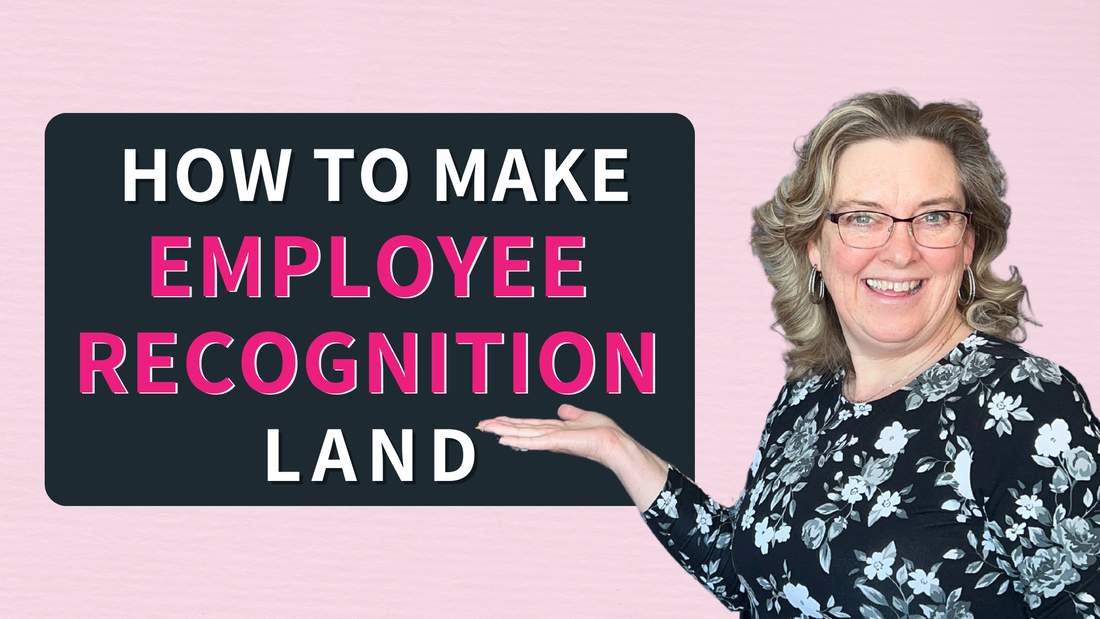
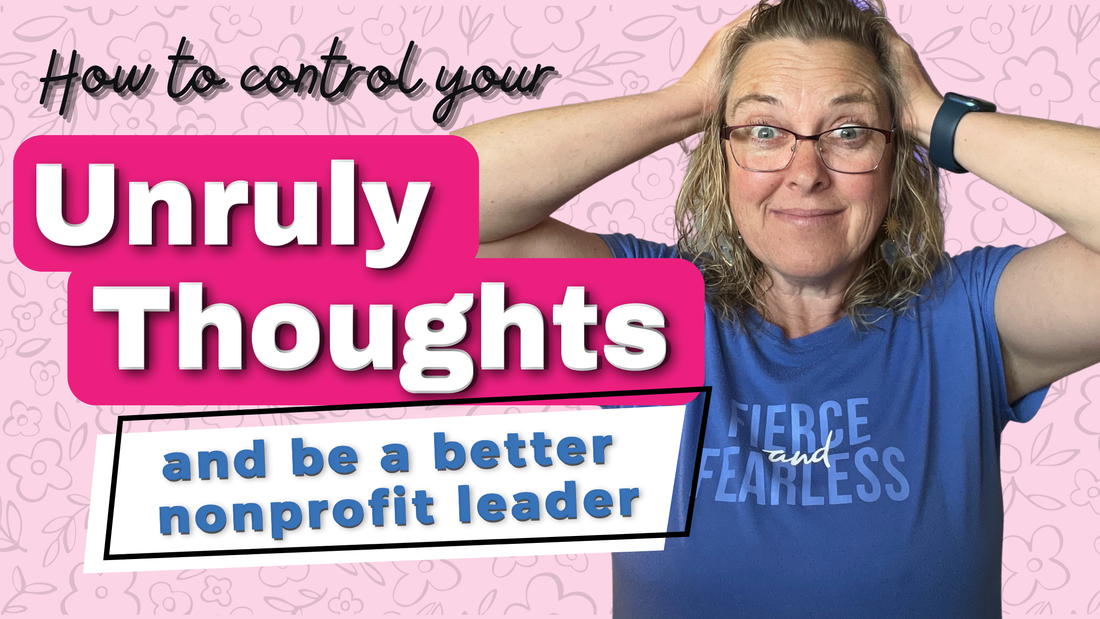
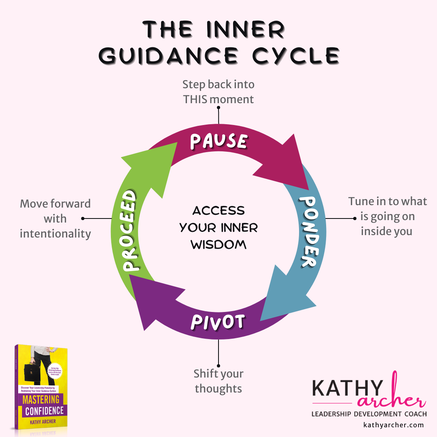
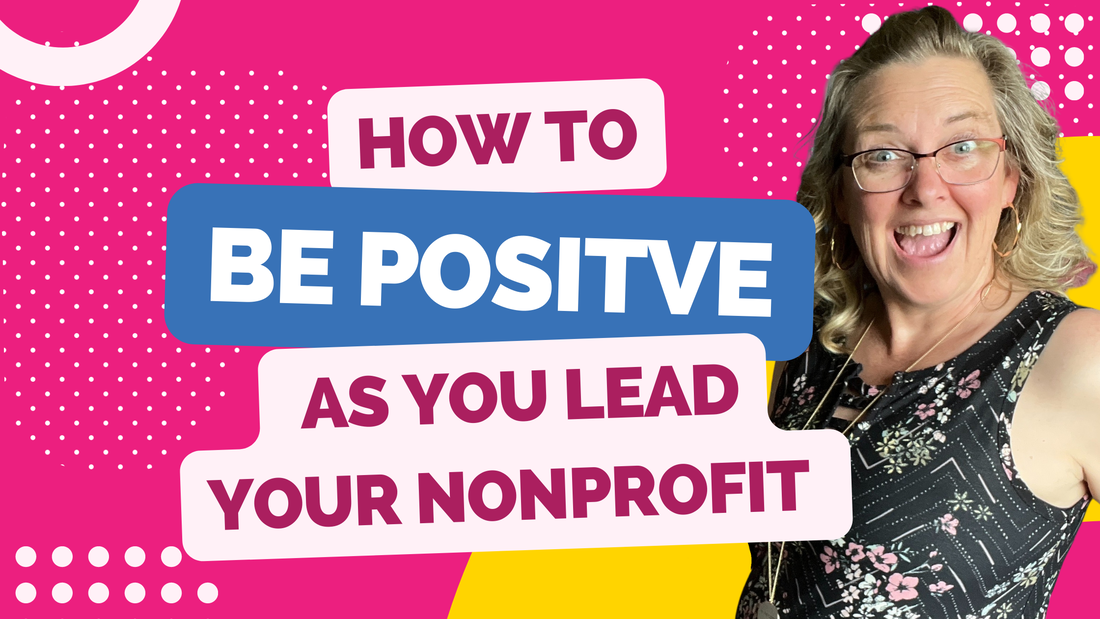
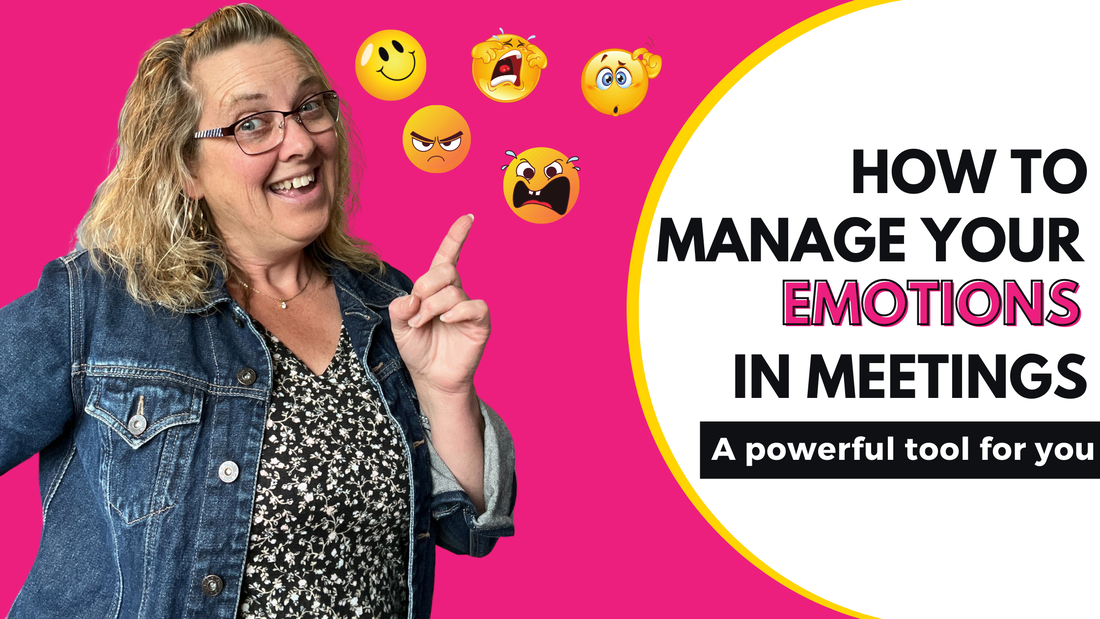
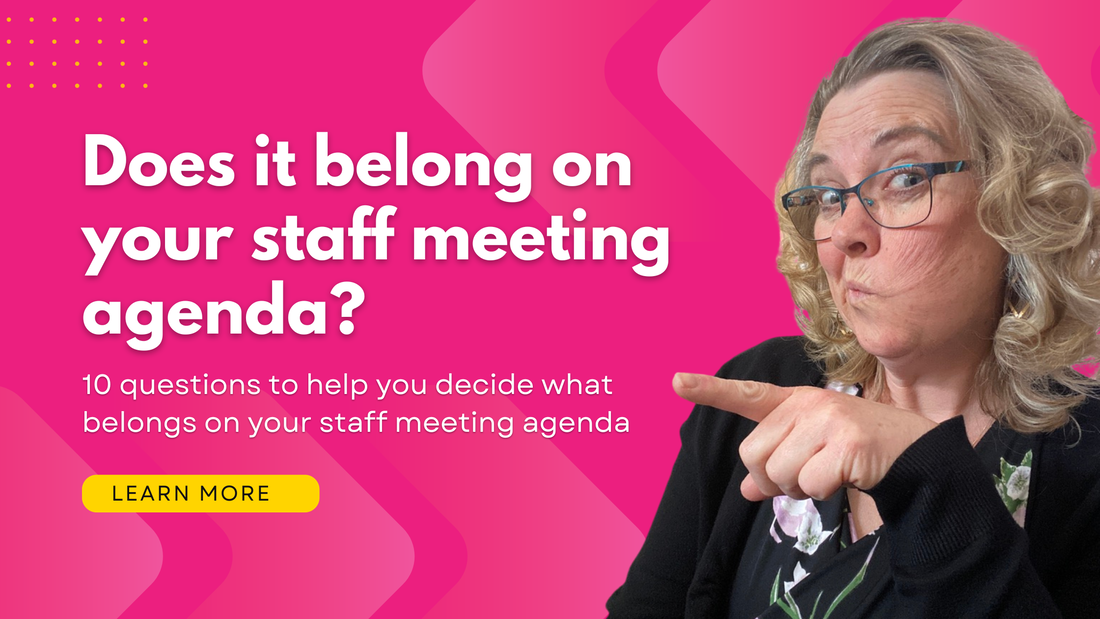

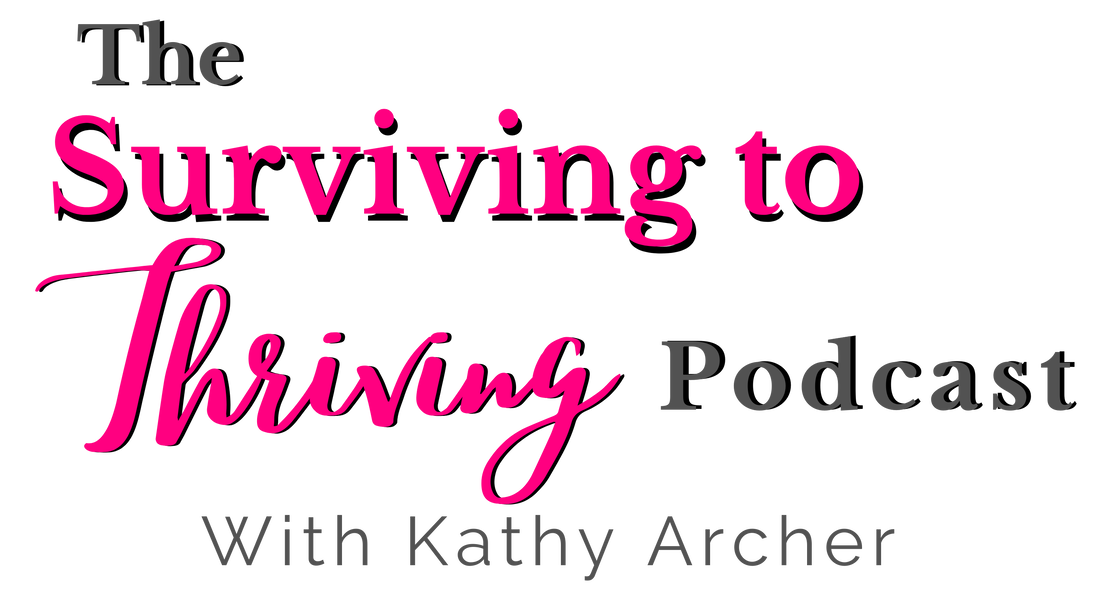
 RSS Feed
RSS Feed
